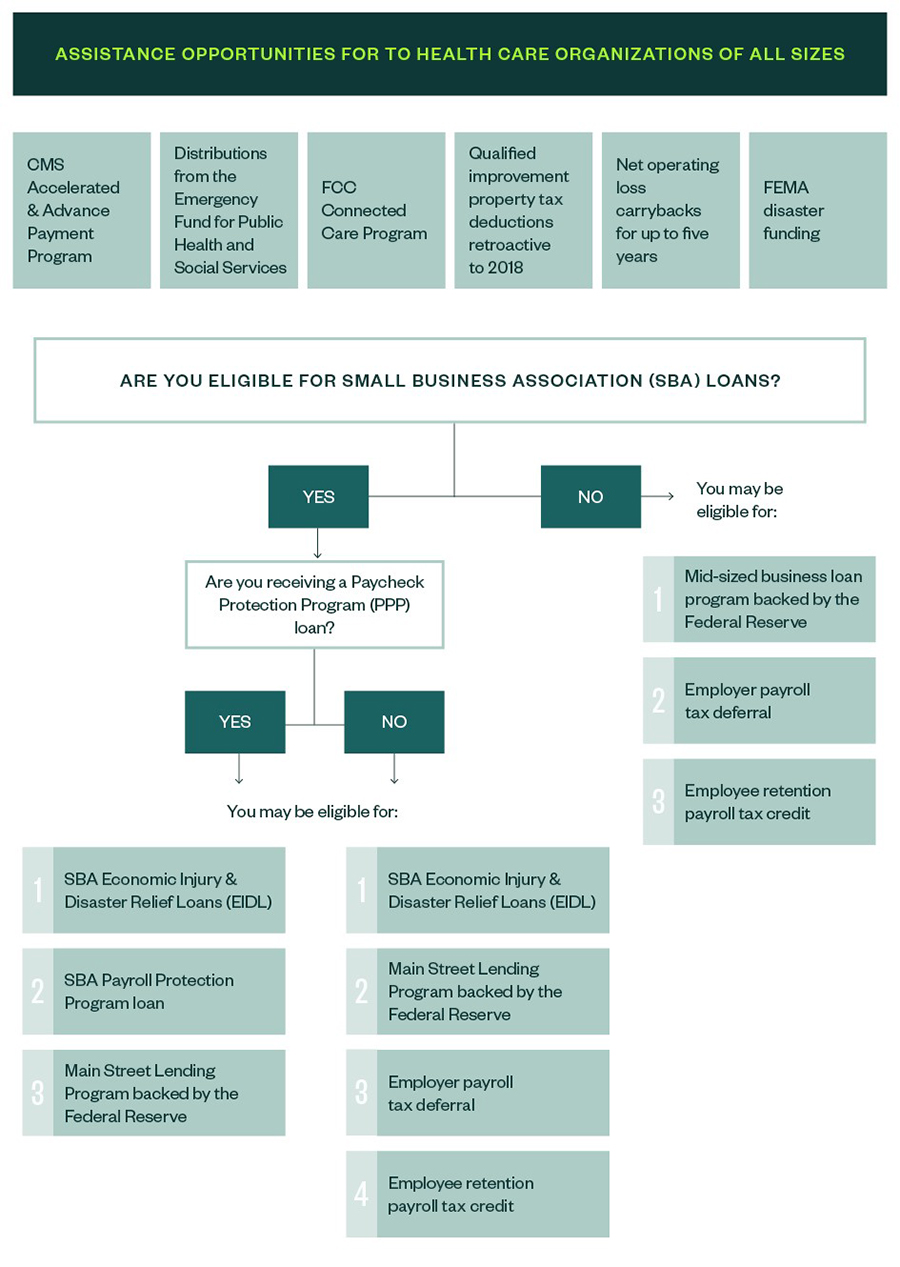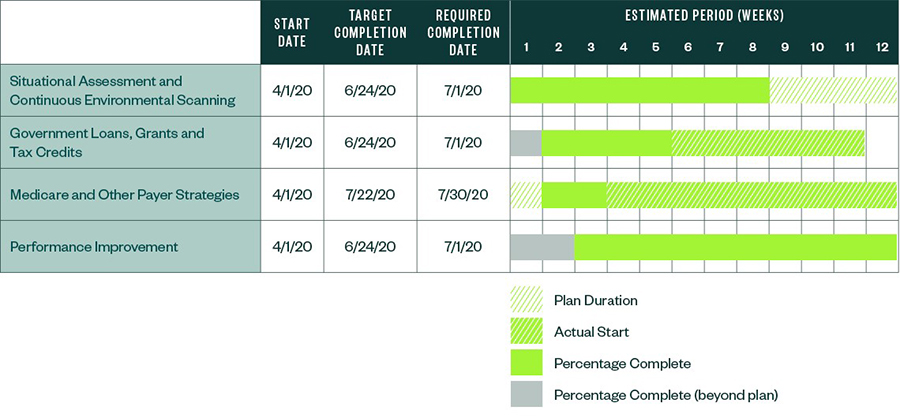

5 Ways to Shift from Fighting Fires to Emerging from COVID-19 Successfully
By Karl Rebay
Partner, Health Care Consulting Group, Moss Adams
By Craig Vercruysse
Partner, Lean Health Care Practice, Moss Adams
Original Publish Date: May 5, 2020
The COVID-19 pandemic has created unprecedented hardships for organizations of all types.
Health care organizations in particular are caught in a precarious position, having to keep their doors open in spite of significant declines in business and cash flow. The federal government is pumping cash into the health system, but health care leaders are having to think quickly and act based on incomplete information.
Every crisis, however, presents opportunities to learn and improve. While the full impact of federal and state decisions might not be realized for quite some time, health care organizations can use the knowledge we are gaining every day during the pandemic to help improve our nation’s health care system.
Leaders need to focus on how they want their organizations to emerge from the pandemic and economic crisis, and start working to make those hopes a reality. Below, we outline five steps to help you kickstart your business strategy, but first some background.
Background
The US health care delivery system is struggling. Quick decisions made primarily to save medical supplies and maximize capacity in response to the pandemic have resulted in the temporary elimination of all elective services—the economic engine of most health care systems.
This has had a major impact on hospitals and providers despite recent plans to relax the restrictions. For health plans or other risk-bearing-organizations (RBO), the downstream impact of widespread unemployment and the cost of COVID-19 services are unclear but looming. At this point, the full impact is still unknown. There are many other health care industry constituents with situations different than those of hospitals and health plans—too many to cite here. Leaders must prepare for continued uncertainty.
While there are many aspects out of leadership’s control, leaders can influence decision-making processes within their organizations that could help mitigate these issues.
There’s no time for waste at the executive and board levels in guiding the organization. As a team, agreeing on organization targets in the short-, mid- and long-term, followed by focused planning and execution to attain those targets, is paramount.
Relentless discipline in checking progress and adjusting actions is needed on a scale most organizational leadership teams and boards aren’t used to maintaining. How you formulate and deploy actions matters a great deal.
Just as the emergency response to the virus triggered the need for clinical and operational command centers, the economic repercussions and evolving opportunities to create a better way for health care requires a business command center— a process whereby leaders strategize and monitor progress towards many important short and longer-term goals.
Steps to Kick Start Your Business Command Center
1. Focus on Cash
New funding mechanisms are being presented, and existing opportunities are evolving. For many of them, leaders will need to act quickly on what opportunities they want to pursue and then ensure they have the means to do so.
Our decision tree outlines steps you can take and opportunities available depending on your circumstances.

Potential opportunities include the following:
- Tax credits and deferrals
- CMS funding advances and grants
- Federal Emergency Management Agency (FEMA) support and federal loan programs
From an operational standpoint, there’s near-term planning that needs to happen and strategies to deploy that will impact cash down the road. Areas to consider include the following:
- Medicare and Medicaid reimbursement strategies
- Revenue cycle cash acceleration strategies
- Settlements with payers
Here’s a high-level hypothetical example of how a comprehensive planning timeline might look.

2. Develop Efficiency Strategies
The skills you learn during the pandemic should include an intense focus on efficiency. Some organizations are deploying staffing, supply chain, and other strategies to reduce costs.
For example, key levers to consider for managing labor costs and efficiencies include the following:
- Eliminate or decrease contract, agency, and traveler utilization
- Manage overtime and premium pay costs by implementing strict protocols and approval process
- Implement a strategic hiring freeze with rigorous position control process
- Develop flex staffing plans for all hospital departments, including both variable and fixed departments
- Push or delay education, orientation, and training (EOT) time to the future to focus labor resources on critical needs
- A reduction in force (RIF) as a last resort, which would include restructuring management to create a flatter organization that’s equipped for quicker decision making while lowering costs
When looking to redeploy resources after the pandemic subsides, don’t lose sight of what you were able to accomplish during this difficult time. It’s a challenging area to address because, of course, staffing strategies impact people, however, it’s important to consider how to increase efficiency. By prioritizing efficiency, you’ll be in a stronger position on the other side of the pandemic.
3. Identify What Is Working and What Is Not
With every aspect of your business impacted, there’s significant opportunity to make widespread improvements by assessing the effectiveness of your current operations. Areas for improvement might include the following:
- Enhancements to your crisis response
- Delivery system enhancements, such as Telemedicine
- Business relationship management, including vendors and payer-provider collaboration
4. Focus on Market Position
The pandemic and the ensuing economic crisis are impacting everyone, and they’re forcing evolution in the industry so leaders must think ahead. Part of that thought process should be about the market position they want to be in when the dust settles. The harsh reality is that this won’t be the last pandemic, and organizations that will get ahead are those that use this as an opportunity to learn and enhance their market position to emerge stronger than they were before. They need to be asking themselves questions to evaluate their current position—and their ideal one. These can include:
- What do we want to look like in the new paradigm?
- Based on our current direction, will we emerge in a position of strength?
- What is our image in the marketplace and do we want to make changes?
- How are we positioned relative to our competitors?
While the external environment may not be crystal clear at this point, smart leaders will be positioning their organizations to make the best of what’s to come.
5. Reengage Around Strategic Planning
Now is the time to start planning. With many regions seeing the peak in this initial wave of the COVID-19 it’s critical to perform a situational assessment and look for ways to evolve your organization. Whether you believe there will be another phase of this pandemic, or you’re preparing for the next one, this is the time to harness the lessons learned and focus on recovery, and for many, reinvention for your long-term future.
Some questions to consider include:
- Are we benefiting from the learning opportunities presented in the pandemic?
- Are we on track to emerge with the ability to invest in our business strategy?
- What have we learned about quality and crisis preparedness and are we able to promote safety of patients and our workforce?
- Have we learned to opearate more effectively and efficiently?
We’re Here to Help
It is fair to say that the world’s reaction to COVID-19 is unprecedented. It is also fair to say that this won’t be the last pandemic. So what are you going to do to improve how your organization operates going forward? To learn more about how to get started, contact your Moss Adams professional.
Karl Rebay has over 25 years of experience in the health care industry, and is a leader with our health care consulting team. He’s focused on providing high-impact health care advisory services to help the firm’s industry clients navigate and succeed in the rapidly evolving national health care landscape. His clients include health systems, hospitals, health plans, long-term care organizations, and IPAs, among others. He can be reached at (949) 623-4193 karl.rebay@mossadams.com.
Craig Vercruysse has more than 20 years of health care leadership experience. He has deployed the Toyota Management System (lean management) across seven acute care hospitals and a 250-physician medical foundation while employed at Sutter Health. He also has broad experience across multiple disciplines, including operations, IT, Electronic Health Record (EHR) implementation, sales, and marketing. He can be reached at (206) 302-6992 or craig.vercruysse@mossadams.com.